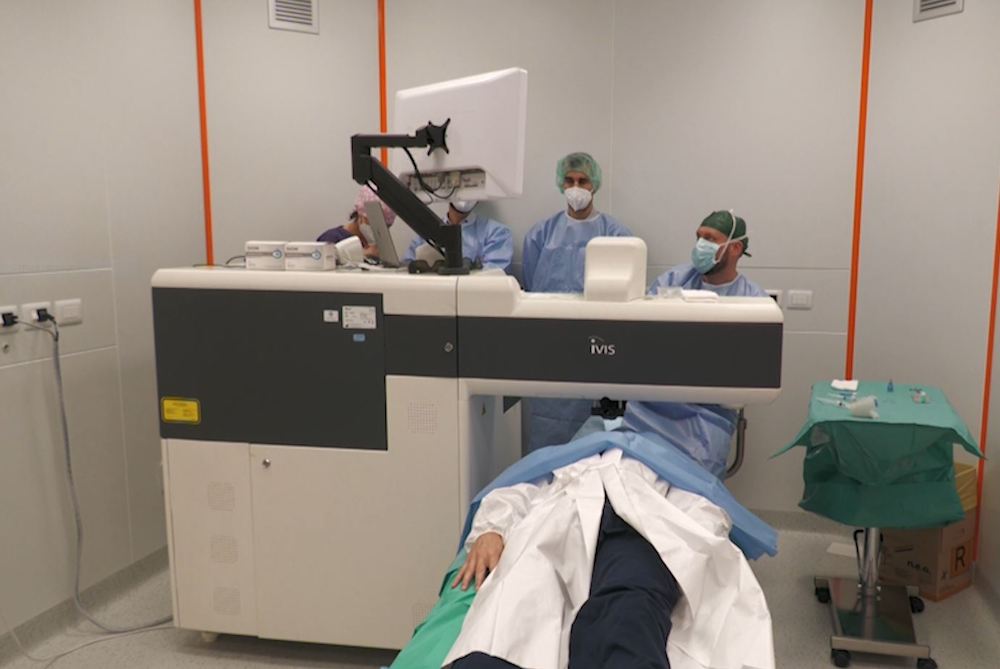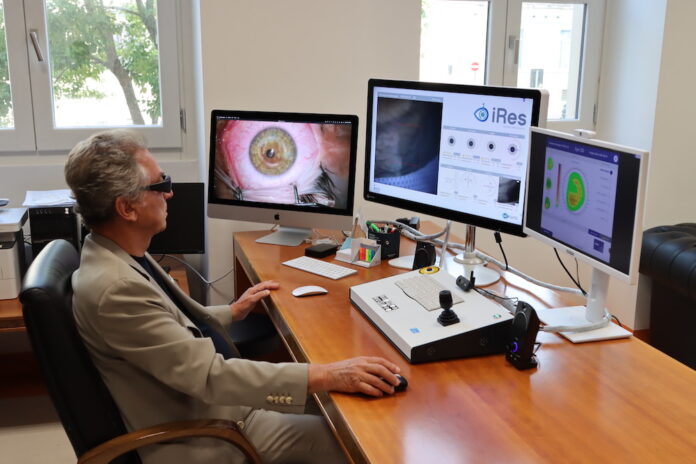Surgeon controlled and guided laser from his office, bringing new meaning to cutting-edge technologies
Telecom Italia (TIM) has used a 5G connection to successfully complete corneal surgery remotely at the Bari Polyclinic in Italy.
Professor Gianni Alessio controlled and guided the iRes 2KHz laser in the 4D Suite platform from his management office in the eye clinic to operate on a patient physically present in the operating room, assisted by a surgical control team. The 53-year-old man was suffering from Cogan’s dystrophy, a condition characterised by the presence of small lesions on the cornea which generate blurred vision, pain and excessive tearing.
TIM said it was the first time the traditional laser treatment needed to remove irregularities in the shape of the cornea had been performed internationally. Professor Alessio operated in real-time, with 3D visualization, via an iVis Remote Control Station.
The telco installed two 5G small cells and routers inside the professor’s room and the operating theatre. The small cells connected back through TIM’s core network via a 10Gbps fibre backhaul link. The successful operation saw a latency of less than 50 milliseconds between the iVis Remote Control Station and the iRes 2KHz laser.

Top banana
Using 5G for remote surgery has become a much-derided application, particularly given how much overhype most early 5G applications received as vendors tried to help telcos justify investing in it – so much so, it even became a viral video featuring banana surgery.
However, for some medical applications, particularly in learning and development, using 5G for process automation and real-time remote control of a surgical operation overcomes several current tele-surgery limitations.
“Carrying out the operation with remote control, through fully automated processes, opens up new frontiers for the ophthalmologist surgeon, allowing him to operate on complex corneal pathologies remotely, in total safety, wherever the operating room is located,” said professor Alessio who is director of the ophthalmology department of the Bari Polyclinic.
“Thanks to the synergy between iVis Technologies, TIM and Polytechnic we have implemented a complete system for process automation and real-time remote control of a surgical operation, overcoming what is still a limitation of the application of telesurgery,” said Bari Polytechnic general director Giovanni Migliore.
“Only a few systems are able to guarantee homogeneity of performance and minimise intraoperative risk by performing operations with the surgeon in a geographical position different from that of the patient,” he added.
“The TIM Group is alongside the world of healthcare to accelerate the process of adopting digital technologies and their integration in the path from prevention to the care of people,” said TIM head of national & local institutional affairs Sabina Strazzullo.
“We use cutting-edge technologies such as telemedicine, augmented reality and virtual reality which significantly benefit from the very high performance of the 5G network,” she said. “The BARIUM 5G project led by the Polytechnic of Bari is a clear example of the skills, technologies and infrastructures that TIM Enterprise…can make healthcare available to reduce the distances between doctor and patient.”
Blockchain for patient records
Bari Polytechnic has set up the healthcare data archiving system with blockchain technology which processes health data with an unalterable recording of the intervention for legal liability.
“Blockchain technology applied to surgery allows for the traceability of each phase of the operation,” said professor Michele Ruta. “Such a data management system, in the healthcare sector, guarantees maximum transparency and reliability, to protect the patient and also the healthcare workers.”
Virtual surgeon
This is not the first time TIM has tried innovating in the telemedicine space. In 2019, the telco facilitated the first 4K remote-surgery consultation in Europe using its 5G network. Professor Giorgio Palazzini, an expert in surgical technologies, remotely participated in a laparoscopic surgery in Terni from Rome via a virtual-reality visor.
Three cameras in the operating room allowed him to observe the procedure, patient biometrics, and internal organs in real time. The 4K video quality and low latency of 5G technology enabled real-time interaction and diagnostics. More than 30,000 surgeons worldwide, including attendees of the 30th International Conference of Digestive System Surgery, watched the event via live multi-streaming.



